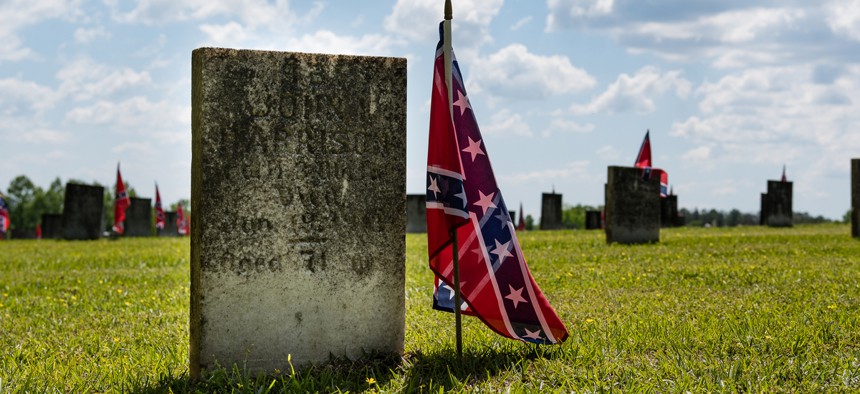
JNix / Shutterstock.com
The U.S. Government Is Wasting Millions Guarding Confederate Graves
It's already spent $3 million to date, according to records obtained by the Associated Press.
Shortly after last August’s violent white supremacist rally in Charlottesville, Virginia, and the toppling of a statue of rebel soldier at Ohio’s Camp Chase Confederate Cemetery two weeks after the demonstration, the Department of Veterans Affairs hired round-the-clock security guards to protect at least eight Confederate cemeteries from potential vandalism, according to records reviewed by the Associated Press.
The documents, which were obtained through the Freedom of Information Act, reveal the VA has spent roughly $3 million on the effort since it began on Aug. 24, 2017. An additional $1.6 million has been earmarked for Confederate monument protection during the VA’s 2019 fiscal year. The funding comes from the VA’s operating budget, not emergency appropriations.
In addition to Camp Chase, private guards working for the VA are in place at Springfield National Cemetery in Missouri; North Alton Confederate Cemetery in Illinois; Woodlawn National Cemetery in Upstate New York; Point Lookout Confederate Cemetery in Maryland; Finn’s Point National Cemetery in New Jersey; Confederate Stockade Cemetery in Ohio; and the Confederate Mound at Chicago’s Oak Woods Cemetery.
A spokesperson for the VA’s National Cemetery Administration told the AP that the security presence was necessary “to ensure the safety of staff, property and visitors paying respect to those interred.”
If there’s a credible threat to a Confederate cemetery or any of its employees, then “of course they should be protected,” said Will Fischer, a Marine Corps combat veteran and Purple Heart recipient who now serves as director of government relations at VoteVets, a progressive nonprofit based in Portland, Oregon. But he and other veterans tell Quartz that any fears of physical violence are wildly overblown, and that the funds would be better spent on care for soldiers who are still alive.
The VA is currently facing personnel shortages at 140 of its 141 medical centers across the country, along with budget gaps that have hampered the department’s ability to recruit qualified physicians, and crumbling infrastructure that sometimes prevents veterans from accessing care. The $3 million already spent on cemetery guards could have been put to use plugging these holes “when thousands of veterans are homeless, are in debt because the were defrauded out of their educational benefits, when the VA is in a hiring crisis, and when 2 million women veterans continue to be underserved,” said Navy veteran Lt. Andrea Goldstein, who served as an intelligence officer from 2009 to 2016.
“I think the VA should fill its estimated 45,000 job vacancies, clear its claims backlog, and do its actual job,” said Matthew Moores, a Marine Corps combat vet and tank commander who was injured in Afghanistan. “When all that is done, then maybe we can talk about spending money to guard cemeteries from imaginary threats.”





